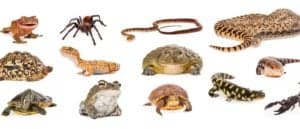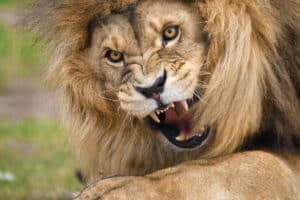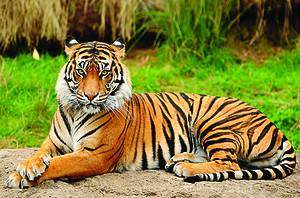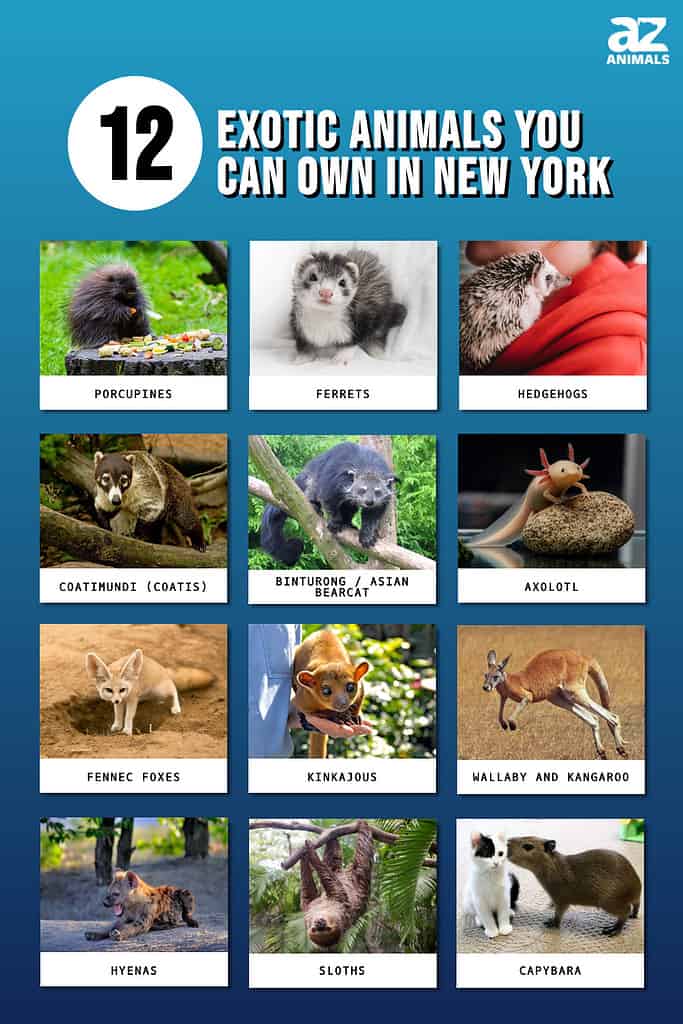
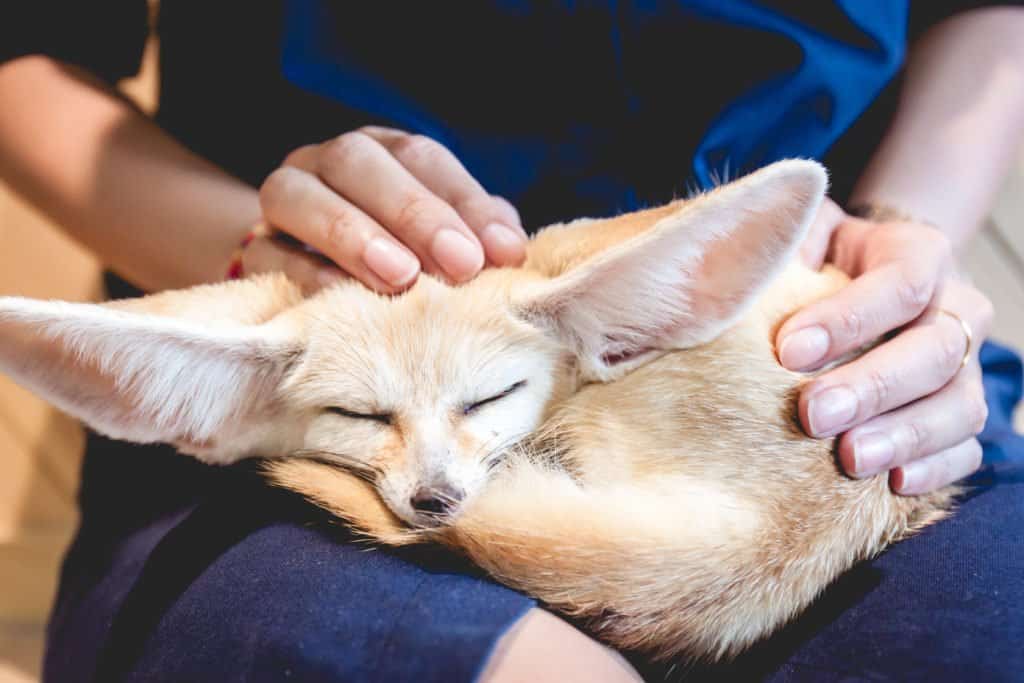
Fennec foxes do not make sounds while walking due to hair on their paw pads.
©Chill Chillz/Shutterstock.com
Exotic pet ownership is a thrill for those wanting a pet that has more grit and moxie than a cat or dog. It is exciting owning a wild animal! Fantasy is usually more charming than reality, but some exotic animals are very pleasant pets once they establish trust with their humans.
New York has several laws and regulations regarding exotic animal ownership. These laws differ between NY state and NY city.
NY State Exotic Animal Ownership Requirements
Before a potential buyer purchases an exotic animal, they need to check with the local board or animal breeder regarding what permits are needed.
All states allowing exotic animal ownership require permits and licenses from state wildlife departments to prove the owner is taking responsibility for the animal. Licenses must be renewed every year and are inexpensive to obtain.
Government-sanctioned exotic animal breeders or shelters assist owners in permit acquisition and renewal. Anyone found with an exotic animal without the proper paperwork is subject to heavy fines and immediate seizure of the animal to a refugee or other government-funded exotic animal location.
NY State vs. NYC Restrictions

NYC is too crowded to allow exotic animal ownership because it risks harm to humans and animals.
©Ryan DeBerardinis/Shutterstock.com
When referencing exotic animal ownership in New York, it is imperative to differentiate between the state of NY and the city of NY.
NYC has stricter laws regarding exotic animal ownership compared to the state. The city is densely populated with people and an escaped exotic animal may cause mass havoc and panic. For instance, kangaroos are legal in NY State because landowners have space to let them hop around and exercise. An escaped kangaroo in NYC would be disastrous, potentially causing car accidents, delays in commutes, or harm to the animal or residents.
NY State property owners have a better chance of providing proper enclosures for large exotic animals while minimizing the risk of harm to the animal or others in the accidental instance of an escape.
Avoid The Big Five

Large snakes like
Burmese pythons
are illegal in NYC because they can slink into plumbing.
©dwi putra stock/Shutterstock.com
Across several states, certain animals are not allowed to be owned outside of government organizations or wildlife conservation groups intending to help the species.
The Big Five are a group of animals no one is allowed to own as pets because they pose too great a risk to humans, or their conservation status forbids it.
The Big Five are:
- Big cats: lions, tigers, jaguars, leopards, cheetahs, bobcats, etc.
- Canids: wolves, coyotes, non-bred fennec foxes, wild dogs, raccoon dogs, etc.
- Bears: sun bears, black bears, sloth bears, etc.
- Venomous and large reptiles: crocodiles, anacondas, boa constrictors, monitor lizards, Burmese pythons, etc.
- Primates: chimpanzees, monkeys, lemurs, etc.
Domestic and feral cats are allowed in both NY State and NY city, as well as large breed dogs like Bernese Mountain dogs, Mastiffs, and Great Danes. However, NYC landlords are permitted to restrict or deny tenants a room if they own a large breed dog.
Exotic Animals Allowed In NYC
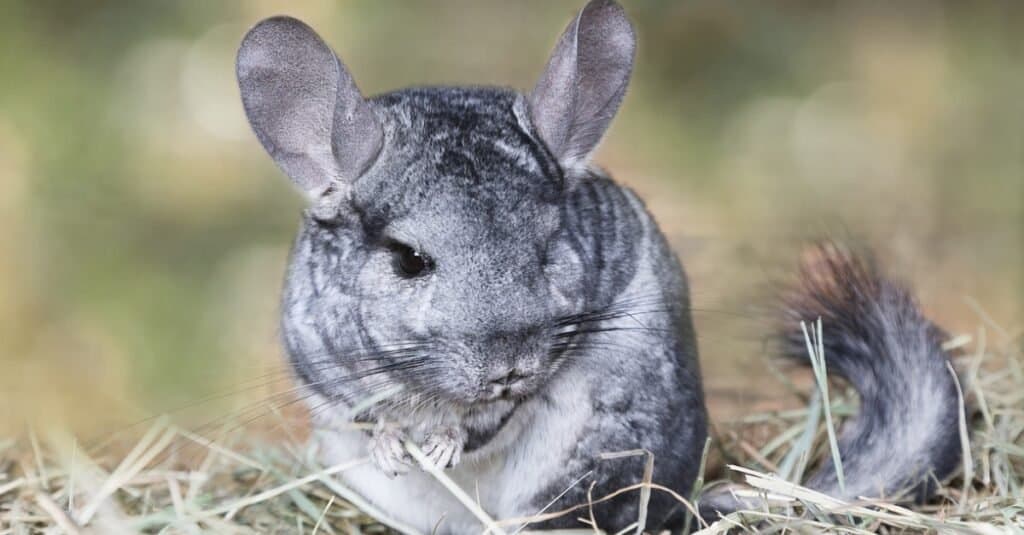
Chinchillas are small rodents who are very skittish, but docile and playful like rabbits.
©iStock.com/alkir
New York City has tight laws regarding exotic animal ownership. The safest option for owners wanting to have a pet in NYC would simply be a cat or medium-sized dog. However, some exotic animals are legal due to their small size and low chance of causing harm to others or escaping.
Common Exotic Pets in NYC are:
- Non-snapping turtles under 4 inches
- Small rodents: gerbils, hamsters, guinea pigs, chinchillas, and rabbits
- Birds: parakeets, parrots, finches, canaries, pigeons
- Small Reptiles: leopard geckos, anoles, bearded dragons
Interestingly, honeybees are legal to own in NYC. Owners must register the hive with the NYC Department of Health and Mental Hygiene.
Exotic Animals Allowed in NY State
All legal exotic animals must be obtained through government-approved organizations like exotic animal breeders or animal shelters. It is illegal for owners to grab animals from the wild and bring them into their homes. It is extremely dangerous to the animal and anyone living in the building.
Exotic animals are not fully domesticated either. They have not adjusted to living with humans like cats and dogs. Many of their feral instincts are still active and they may will attack if threatened. If an exotic animal is too difficult to handle, there are shelters and amnesty days where owners may relinquish their exotic animals to proper authorities who will find them suitable habitats without releasing them into the wild.
Here are some exotic animals which residents may legally own in NY State:
1. Porcupines
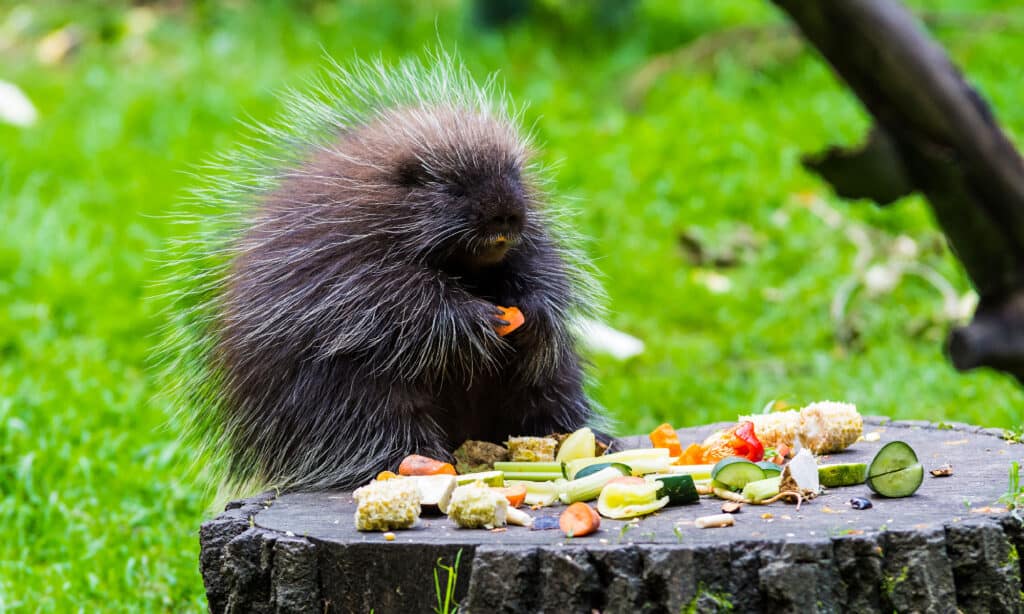
Porcupines have over 30,000 quills on their body which they use for self-defense when scared.
©iStock.com/henrik1978
| Permit Required | Weight | Lifespan | Care Level | Diet | Trainable |
| Yes | 20 pounds | 18-30 years | Medium – Difficult | Herbivore | Possible |
Several types of porcupines are legal to own in NY. It is possible to have the African-crested porcupine, prehensile-tail porcupine, and the Palawan porcupine. Porcupines are large rodents, easy to keep track of, and have a low risk of harming anyone if they escape. Domestic porcupines cannot survive in the wild on their own after being with a human all their life.
Porcupines should have large spaces to roam around. They benefit from indoor-outdoor habitats that allow them to forage for food in a wide yard and return inside to sleep to avoid predators at night. These animals love to climb, so providing them with tall objects will help keep them out of trouble.
Porcupines need a diet of evergreen needles, bark, berries, seeds, grass, roots, vegetables, and hay to stay healthy. Fruits are an excellent snack, though should be given sparingly as they are high in sugar.
Like all rodents, their teeth continually grow throughout their life. This means they require wood chews or strong toys to help them file their teeth down.
Porcupines are docile animals and may grow comfortable with their owners once trust is established. Some may enjoy being held or hugged once they feel safe. Porcupines only raise their quills when they are afraid and feel threatened. If they feel safe and secure, the quills lie flat, and there is little risk of harm.
2. Ferrets

Ferrets perform a “war dance” during which they leap around and play.
©Stephanie’screativeImages/Shutterstock.com
| Permit Required | Weight | Lifespan | Care Level | Diet | Trainable |
| Yes | 1.1-4.4 pounds | 5-10 years | Easy to Medium | Hypercarnivore | Yes |
Ferrets are adorable animals that are closely related to weasels. They are hypercarnivores, meaning they require an all-meat diet to stay healthy. In the wild, ferrets consume all parts of an animal for nourishment. Ferret owners suggest feeding a “frankenmeat,” a hodgepodge of assorted organs from different animals.
These little weasels can be trained to use a litter box and follow some commands. Additionally, they are very wily and love to play. Ferrets bond with humans exceptionally well, allowing snuggling, petting, and light playing daily. Provide ferrets with a large enclosure so they have a safe place to sleep, pee, poop, and live while you are out. A ferret should not be left unattended or else they may harm themselves and the house by chewing on wires or objects.
Ferrets will try to steal small objects and hide them in their den. If something goes missing, there is a high chance the ferret has stollen it!
Ferrets do best when with a partner or littermate to keep them company. They are very social animals that like attention. However, avoid mixing ferrets with cats and dogs, unless they are all familiar with each other. Feral cats prey on ferrets in the wild and unless all animals are raised together, kitties might harass the ferret.
3. Hedgehogs

Domestic African hedgehogs can be placed in
guinea pig
balls to give them extra exercise.
©yul38885 yul38885/iStock via Getty Images
| Permit Required | Weight | Lifespan | Care Level | Diet | Trainable |
| Yes | 8-21 ounces | 3-4 years | Easy | Insectivore | No |
The African pygmy hedgehog is the most common exotic hedgehog legal to own as a pet. These little critters are not rodents. They are more closely related to shrews and voles. Hedgehogs are docile animals that rarely bite, preferring to roll into a ball and extend their quills lining their back rather than try to fight. Owners who establish trust and security around their hedgehogs may pet them gently or carry them around the house.
Hedgehogs require insects and vitamin supplements to balance their diet. Insects are a good source of protein but lack other essential vitamins and nutrients. Exotic veterinarians can suggest several vitamin supplement powders to add to store-bought insects for optimal health.
Hedgehogs should be kept in a small terrarium with guinea pig bedding or fleece carpet, along with several small toys and exercise wheels. The terrarium should be spot cleaned every day, and deep cleaned weekly.
Interestingly, hedgehogs possess a high tolerance for toxins due to their diet of beetles, wasps, and sometimes venomous snakes in the wild. Of course, this does not mean owners should feed them venomous insects or reptiles!
4. Coatimundi (Coatis)
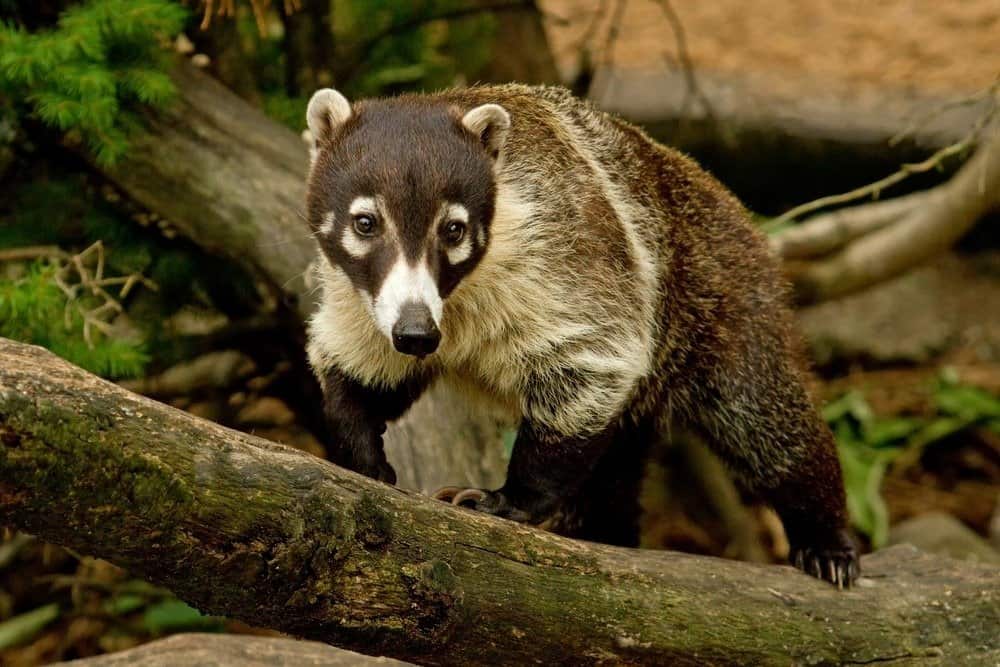
Coatis are intelligent animals, capable of learning to go for leash walks with positive reinforcement.
©Cynthia Kidwell/Shutterstock.com
| Permit Required | Weight | Lifespan | Care Level | Diet | Trainable |
| Yes | 7-14 pounds | 14 years | Medium-Difficult | Omnivores | Yes |
Coatis are cute, raccoon-like animals that live in canyons and hills in Arizona, New Mexico, and Texas. They are one of the few exotic animals that can be trained to use a litter box and go for leash walks once they have adjusted and learned proper commands. Owners should use caution around coatis because they have long claws that may accidentally injure their owners.
Coatis are omnivores, meaning they will eat plants and animals if they can get them. In captivity, they should have a balance of insects, lean meats, and vegetables. Fruits are a healthy treat but should not be given often because of high sugar content. Owners must secure all garbage cans and access to food. Coatis have an excellent sense of smell and will search for food if given a chance.
Coatis do not like being in small spaces or cages. Allow them to roam around the house to explore, with a section or corner of the house dedicated to them to sleep, rest, and use their litter box. These animals spend the majority of their life in trees, so provide ample climbable surfaces for them to simulate their natural habitat.
5. Binturong / Asian Bearcat

Bearcats will investigate new things from above as a way to keep themselves safe.
©TassiloRau, CC BY-SA 3.0, via Wikimedia Commons – License
| Permit Required | Weight | Lifespan | Care Level | Diet | Trainable | |
| Yes | 24-71 pounds | 15-25 years | Medium | Omnivore | Yes |
Arctictis binturong, or the Asian bearcat, is a unique animal that looks like a cross between a tree-climbing bear and a big cat. They are very cute and curious animals, having a habit of exploring and investigating new objects from the safety of the treetops.
When keeping one indoors, provide them with plenty of climbable objects and space to walk. They spend most of their life in trees, so a lot of sturdy branches and trees are needed to make them feel comfortable inside.
Bearcats are omnivores, feeding on fish, bird eggs, insects, leaves, berries, vegetables, lean meats, and some fruits. Garbage can lids must be secure because they may try to sniff out leftovers for a late-night snack.
Hand-raised bearcats may become affectionate with their owners over time, but caution should be taken since they are not comfortable with hugging or open affection. They might become defensive with strangers and should not be pushed into meeting new people quickly.
Fun fact: they smell like buttered popcorn because of bacteria on their body!
6. Axolotl
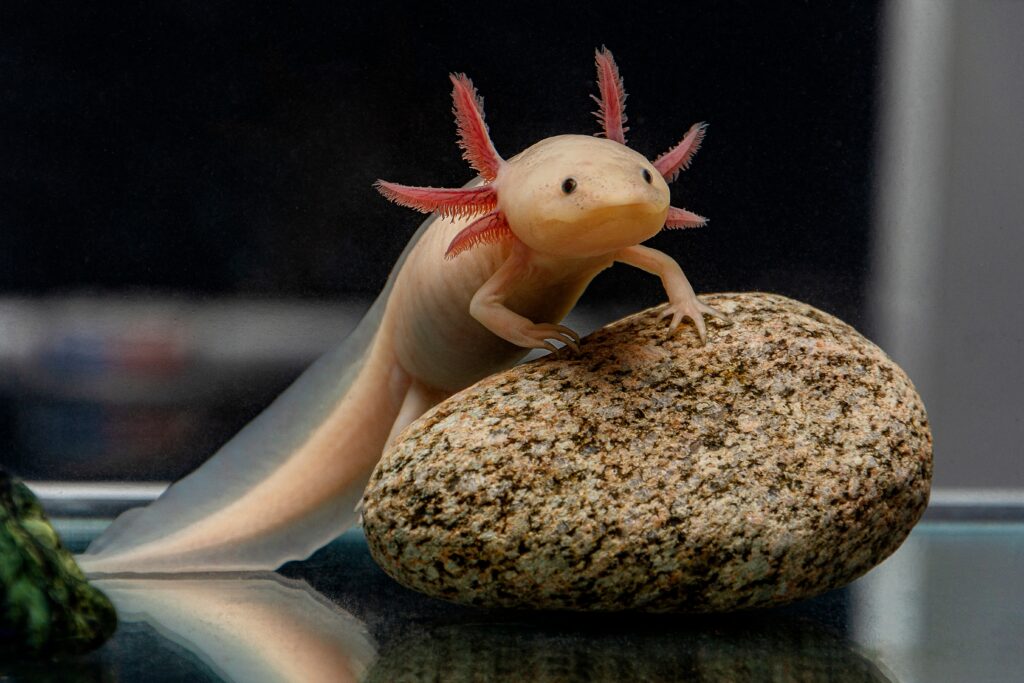
Axolotls are amphibians, making them capable of breathing in water and on land.
©Iva Dimova/Shutterstock.com
| Permit Required | Weight | Lifespan | Care Level | Diet | Trainable |
| Yes | 2-8 ounces | 10-15 years | Easy | Worms | No |
Axolotls are rare pets to own in any state because of their conservation status. These salamanders are critically endangered and only live in still-water lakes in Lake Xochimilco and Lake Chalco in Mexico. Their skin is extremely sensitive to foreign substances, and they will become sick with shifting temperature changes or improper diet.
Axolotls require a 10 to 20-gallon tank of water and should not be placed with other animals, except with similar-sized axolotls. The tank should have a sealed lid to prevent an axolotl from accidentally escaping. They like to explore their surroundings and will remember the tank opens at the top. Design the bottom of the tank with aquarium sand or large pebbles that cannot be eaten. Axolotls will try to devour anything in the tank, and small rocks will cause impaction (blockage in the digestive tract). The tank should have a filter and a thermometer regulating the temperature in the low to mid 60 degrees Fahrenheit.
Axolotls primarily eat nightcrawlers like large earthworms, bloodworms, or frozen shrimp. They have a habit of trying to eat anything they can fit into their mouth!
Owners should avoid touching their pet axolotls because their skin is extremely sensitive to the oil on human hands. As long as their tank is clean and maintained well, axolotls are relatively easy to care for.
7. Fennec Foxes
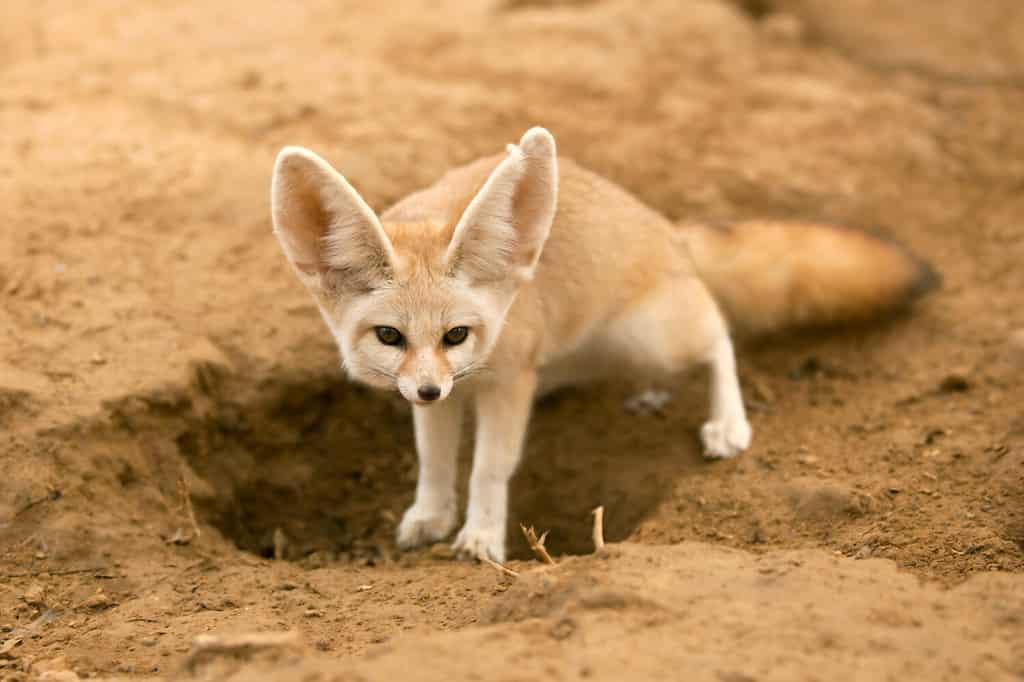
Fennec foxes have the largest ears of all canids in comparison to their body.
©hagit berkovich/Shutterstock.com
| Permit Required | Weight | Lifespan | Care Level | Diet | Trainable |
| Yes | 1.5-3.5 pounds | 10-14 years | Medium – Difficult | Omnivores | Possible |
It is the dream of many to own a fox. They look similar to dogs but with pointed muzzles and bushy tails. Fennec foxes are the perfect mix of a fox and small dog.
Fennec foxes adapted to desert life, meaning they will need a lot of space to roam around. They do not handle temperatures below 68 degrees Fahrenheit well, so they should be housed indoors during the winter or in a dedicated room capable of producing constant heat. Fennec foxes are extremely vocal and active animals, needing room to run, jump, and dig to expel their energy.
There are mixed answers as to whether fennec foxes can be trained. Some believe with constant care and positive reinforcement they can learn to use a litter box and follow some basic commands. Others believe they cannot be trained because their feral instincts prevent it.
Fennec foxes feed on a wide diet of insects, small rodents, lizards, birds, bird eggs, roots, and vegetables. Domestic fennec fox owners provide their pets with cat and dog food to supplement their diet.
8. Kinkajous
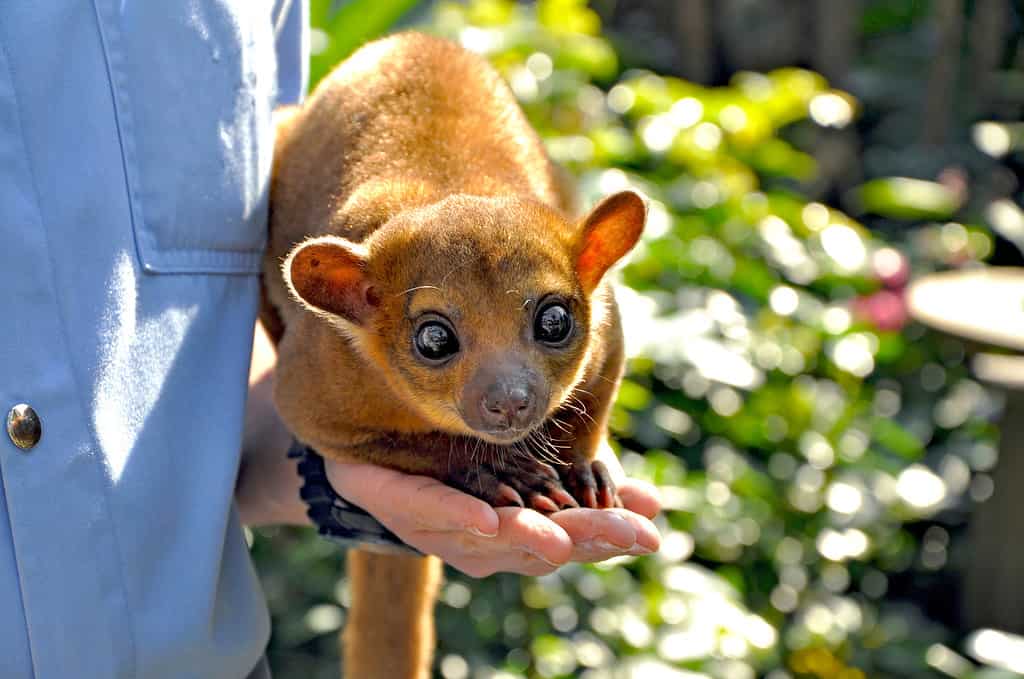
Kinkajous use their prehensile tails to wrap around trees like an extra appendage.
©Lina Shatalova/iStock via Getty Images
| Permit Required | Weight | Lifespan | Care Level | Diet | Trainable |
| Yes | 10 pounds | 20-25 years | Difficult | Omnivores | Possible |
Kinkajous are small animals that look like a cross between a raccoon and a monkey. These animals are difficult to handle, being very anxious and aggressive during certain times of the year. While training them is possible, there are reports of these animals biting their owners or zookeepers regularly.
In the wild, kinkajous spend the majority of their life in trees. These animals are nocturnal, meaning they will be most active at night while everyone is sleeping. Pet owners must simulate their environment by giving them plenty of strong branches and hammocks for sleeping and playing during the night. They are very vocal as well, making it difficult to get a full night’s sleep.
Kinkajous should eat a balance of lean meats and vegetables. Fruits may be given as a treat.
Owners should adopt a kinkajou when the animal is young to establish a bond as soon as possible. Adopting an old kinkajou will take more time for the animal to acclimate to your home and lead to a higher risk of injury from bites or scratches.
9. Wallaby and Kangaroo
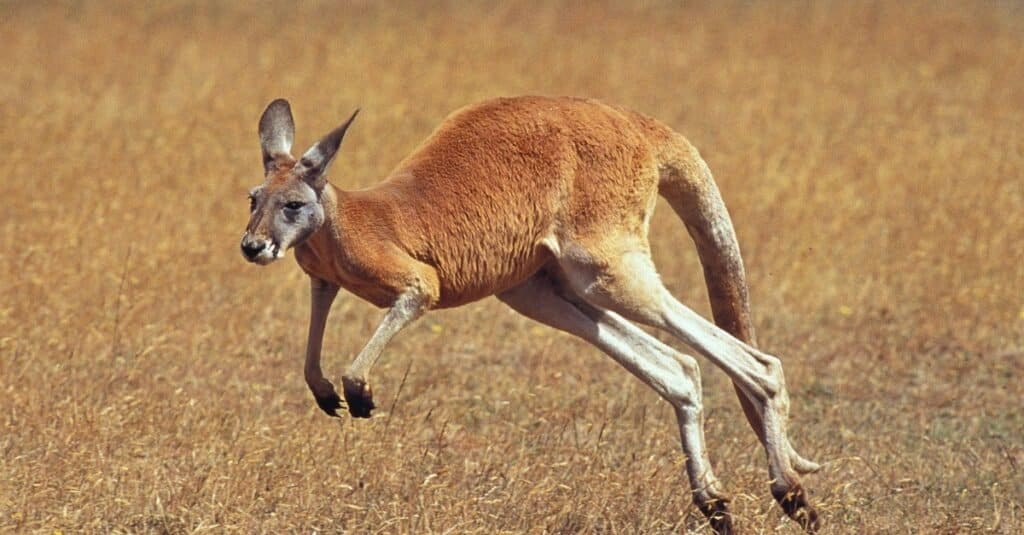
Red kangaroos can reach speeds of 50 mph.
©iStock.com/slowmotiongli
| Permit Required | Weight | Lifespan | Care Level | Diet | Trainable |
| Yes (both) | Wallaby: 53 pounds Kangaroo: 100 pounds | Wallaby: 11-14 years Kangaroo: 8-25 years | Medium (both) | Herbivores | Wallabies: Possible Kangaroos: No |
Wallabies and kangaroos are remarkably similar animals. They belong to a family called Macropods, which means “large foot.” The defining trait of these animals is their large feet which they use to bound around the Australian outback.
For the safety of the animals and owners, keep wallabies and kangaroos as indoor/outdoor animals. Both animals require a large space to run. Their long tails are powerful and can knock over delicate objects while in the house. Owners should only adopt these animals if they have a yard with several acres of land for them to roam, as well as a large fence to prevent escape.
Both marsupials are herbivores, needing a diet of grasses, roots, hay, pellets, and vitamin supplements to sustain a healthy body.
Wallabies and kangaroos should be adopted at an early age to establish a close connection to their owners. Both may become openly affectionate and friendly with positive reinforcement and proper care. Establishing trust with an older kangaroo or wallaby may be difficult and dangerous since kangaroos are powerful animals, capable of breaking bones with their strong hind legs.
10. Hyenas
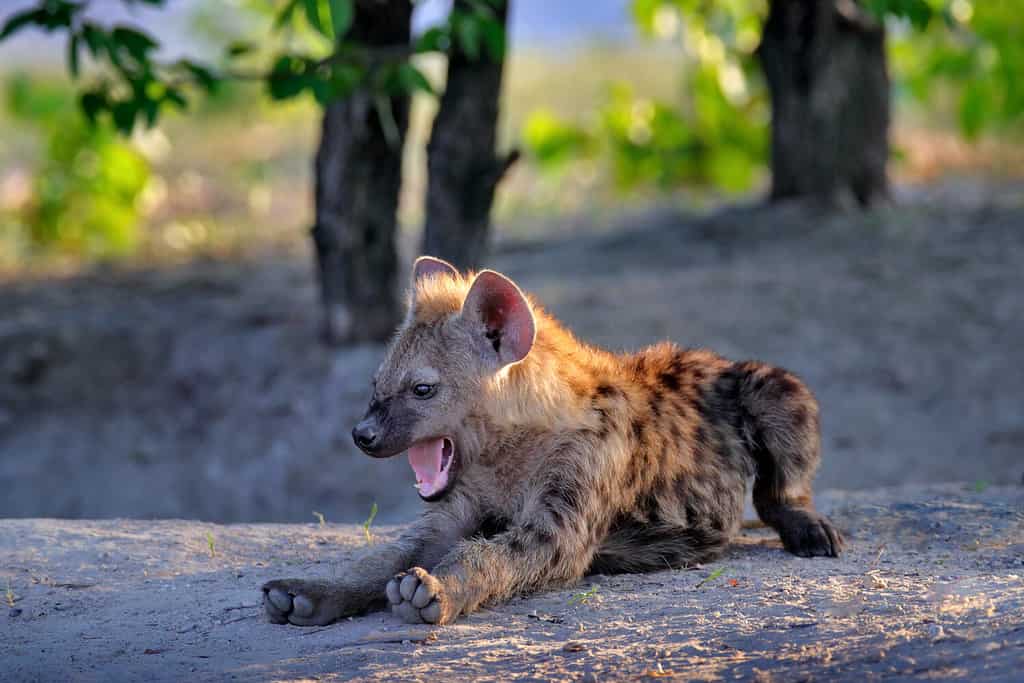
Hyena pups are easy to handle while they are young, but they become very difficult once they mature.
©Ondrej Prosicky/Shutterstock.com
| Permit Required | Weight | Lifespan | Care Level | Diet | Trainable |
| Yes | 90-140 pounds | 20-40 years | Difficult | Anything | No |
Possibly the most surprising entry on this list, hyenas are technically legal to own in NY state. To clarify, it is illegal to own big cats and wild canids (dogs) in all areas of NY state, including NYC. However, hyenas are not cats or dogs. They are in a group called Feliformia, which is not covered by NY state law. However, NYC has implicit rules against hyena ownership.
Now, owning a hyena may sound enticing, but fantasy is more appealing than reality. Hyena pups are similar to medium-sized dogs, capable of growing affectionate and friendly with whoever is feeding and caring for them. When they reach maturity, their feral instincts kick in which leads to accidental bites or attacks.
In the wild, hyenas will eat whatever they can get their jaws on. This includes fresh meat, carrion (dead meat), vegetables, birds, insects, rodents, and lizards.
Hyena cubs can be kept indoors and fed assorted meals of meat, vegetables, and some fruits as a treat. Adult hyenas need more space and should be kept as indoor/outdoor pets.
11. Sloths
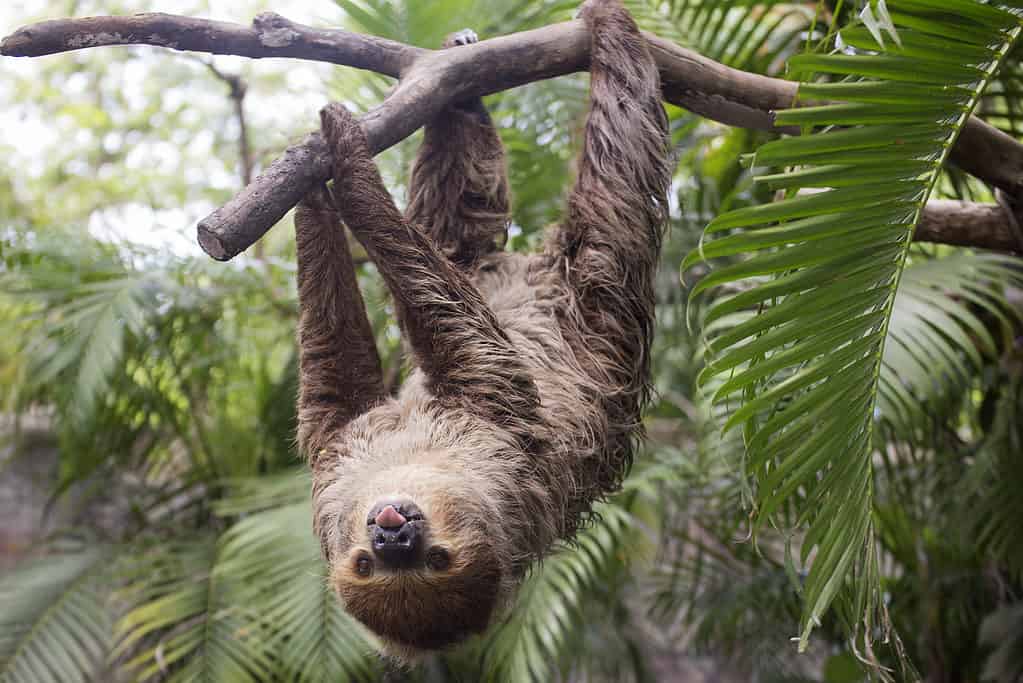
Sloths are very expensive pets to keep healthy. They are not accustomed to living in North America.
©iStock.com/Kung_Mangkorn
| Permit Required | Weight | Lifespan | Care Level | Diet | Trainable |
| No | 9-17 pounds | 20-30 years | Medium | Herbivore | No |
The two-toed sloth is the only sloth that can be legally own as a pet in the U.S. While some states forbid owning sloths, NY state allows sloth ownership without a permit. Sloths are incredibly slow animals that cannot survive in North America by themselves. There is little risk of them harming the environment because they are incapable of eating any vegetation in the area or harming humans.
However, while they are not the most dangerous exotic animals, they are not the most interactive animals either. Sloths do not like being affectionate or socializing with other sloths or humans.
Two-toed sloths are native to Central and South American jungles. Pet owners must simulate a similar environment for them to thrive as pets. This includes having abundant trees and branches strong enough to support their weight, hot and humid temperatures all year round, and a diet of leaves exclusive to Central and South American trees.
The oldest sloth living in captivity was a 50-year-old Linne two-toed sloth named Paula.
12. Capybara

Capybaras benefit from social activity and being around other animals.
©CoralCapy/Shutterstock.com
| Permit Required | Weight | Lifespan | Care Level | Diet | Trainable |
| Yes | 77-150 pounds | 8-12 years | Medium | Herbivore | Yes |
Finally, the last animal on this list of exotic pets legal in NY is a capybara. These are the biggest rodents in the world and make interesting pets with their docile nature and social personalities. They are still wild animals, but their calm demeanor makes them moderate pets to own, similar to tending to a pig. In fact, capybaras are known as “water hogs.”
Capybaras are large rodents, needing a lot of space to graze and roam. Keeping them in a wide backyard with a pool and bales of high-quality hay will make them incredibly happy animals. Supplement their diet with vitamins recommended by an exotic animal veterinarian or capybara breeder and they should live a long and healthy life.
Capybara will become affectionate with their owners, similar to guinea pigs. They like social interaction, so the more an owner plays with them the better. Owners may want to consider adopting two capybaras to combat loneliness and depression, which they are prone to if left alone for too long.
As with other rodents, capybaras need plenty of sturdy chew toys to trim their teeth.

Small reptiles like ball pythons are legal in NY because they do not count as large reptiles.
©David Kenny/iStock via Getty Images
Remember, owning an exotic animal is not like having a domesticated cat or dog. They are still wild animals that have strong instincts to defend themselves from larger predators, including humans. Owners should always use caution when caring for these animals, perform diligent research on their individual requirements for optimal health, and seek out professional help regarding their overall care.
Summary of the Top 12 Exotic Animals You Can Own in New York
| # | Exotic Animal | Permit Required |
|---|---|---|
| 1 | Porcupines | Yes |
| 2 | Ferrets | Yes |
| 3 | Hedgehogs | Yes |
| 4 | Coatimundi (Coatis) | Yes |
| 5 | Binturong / Asian Bearcat | Yes |
| 6 | Axolotl | Yes |
| 7 | Fennec Foxes | Yes |
| 8 | Kinkajous | Yes |
| 9 | Wallaby and Kangaroo | Yes |
| 10 | Hyenas | Yes |
| 11 | Sloths | No |
| 12 | Capybara | Yes |
The photo featured at the top of this post is © Warren Metcalf/Shutterstock.com
Thank you for reading! Have some feedback for us? Contact the AZ Animals editorial team.



